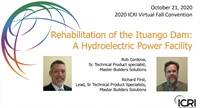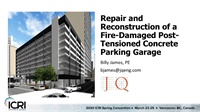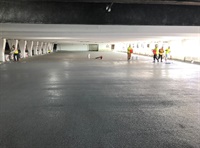
- Presenters:
- Dr. Thomas M. Frankie | Daniela Mauro
- Duration:
- 51 Minutes
- Format:
- Audio and Video
- License:
- Short Description:
- On August 9, 2019, Tyson Foods' Holcomb, Kansas beef plant experienced the first large fire in the meat processing industry in nearly 20 years. The long-burning fire precipitated the collapse of a portion of the high roof over the mechanical mezzanine, which housed equipment for numerous critical plant processes. This took portions of the plant, the second largest in the United States, out of operation for months. The pressures of substantial business interruption costs, as well as the market consequences for cattle feeders from the Southern Plains region, necessitated a rapid response. This presentation highlights the investigation into the extent of damage to precast members, including visual inspection, nondestructive and laboratory evaluations, testing, simulation, and analyses. Based on this investigation, members were identified for repair or removal and replacement.
- Price:
- $15.00 - $25.00

- Presenters:
- Fred Goodwin
- Duration:
- 1 hour, 4 Minutes
- Format:
- Audio and Video
- License:
- Short Description:
- Concrete is the most widely used construction material and can be durable for hundreds of years; however, the main cause of concrete deterioration is from corrosion of reinforcing steel. Steel is thermodynamically unstable and will eventually oxidize to a lower energy state. The rate of deterioration in new and existing structures can be modeled to predict the service life based on the severity of the service environment, the concrete quality, the ingress of deleterious materials, and other factors to various degrees of success. This presentation will provide an overview of many of the service life models currently in use and provide an evaluation protocol for their application related to both new and existing structures.
- Price:
- $10.00 - $40.00

- Presenters:
- Dave Fuller | Keith Kesner, P.E., S.E. | David G. Tepke | John Landry | John McDougall, CSRT | Aamer Syed
- Duration:
- 1 hour
- Format:
- Audio and Video
- License:
- Short Description:
- This 60-minute session will be comprised of a 10-15 minute introduction to ACI 562, followed by a 45-minute discussion by a moderated panel of various experienced stakeholders in the concrete repair industry, including Specifiers, Contractors, Manufacturer/Distributors, and Owners.
- Price:
- $0.00 - Base Price


- Presenters:
- Robert M Cordova | Richard First
- Duration:
- 30 Minutes
- Format:
- Audio and Video
- License:
- Access for 6 month(s) after purchase.
- Short Description:
- The Ituango dam is an embankment dam that is currently under construction on the Cauca River in Colombia. The largest hydroelectric power plant in Colombia’s history. Three large diversion tunnels used to divert the water from the river around the construction site during construction collapsed as a result of heavy rainfalls. The nearly completed pump house had to be flooded to accommodate premature water build-up in the reservoir. These tunnels would need to be permanently sealed. “Pre-stoppers” would need to be constructed in place to serve as bulk heads between which would ultimately be excavated and back-filled with concrete to permanently seal the tunnels. Additional to standard anti-washout properties, the grout had to withstand swiftly flowing water and exhibit an extended working time at temperatures above 32 degrees C. A custom grout was developed for this application. In the end, hundreds of grout micropiles were tremied, consuming more than 1,650 tons of grout, to produce...
- Price:
- $15.00 - $25.00

- Bundle:
- Fall Conference Bundle
- Presenters:
- Billy D. James, P.E.
- Duration:
- 22 Minutes
- Format:
- Audio and Video
- License:
- Access for 6 month(s) after purchase.
- Short Description:
- Post-tensioned concrete is a strong and durable material for construction of exposed parking structures. These types of structures are also fire resistant, but they can be damaged depending upon the severity of the fire. The structure in this presentation suffered significant fire damage early in its construction. The presentation will cover the discovery and testing methods used to determine the extent of fire damage, and the design of the repairs that were instituted to restore strength and allow construction to continue.
- Price:
- $15.00 - $25.00

- Bundle:
- Fall Conference Bundle
- Presenters:
- Leon Geoxavier | Lynne Vu
- Duration:
- 24 Minutes
- Format:
- Audio and Video
- License:
- Access for 6 month(s) after purchase.
- Short Description:
- In new construction, cracks can appear for variety of reasons: curing, temperature deviation, pressure from adjacent conditions, or settlement. This presentation will outline various types of cracking, how to plan to avoid them, and how to address them after concrete has been placed.
- Price:
- $15.00 - $25.00

- Bundle:
- Fall Conference Bundle
- Presenters:
- Mr Khiam Sarwar
- Duration:
- 25 Minutes
- Format:
- Audio and Video
- License:
- Access for 6 month(s) after purchase.
- Short Description:
- Due to improper design or implementation sometimes Part of the New projects are re-executed or repaired. Islamabad - Rawalpindi BRTS (Bus Rapid transit System) Consisted of 20 Stations Covering around 23 km path connecting twin cities. Each station Roof Consisted of ACP Sheets Fixed on Aluminum Frame with Steel supports. The joints of ACP sheets were filled by Silicon but improper materiel and workmanship caused leakage in joints. Total length of joints was over 400,000 RFT. Leakage was invariably from almost every area.
- Price:
- $15.00 - $25.00

- Presenters:
- Charu Chaudhry
- Duration:
- 44 Minutes
- Format:
- Audio and Video
- License:
- Short Description:
- Historic 19th and 20th century buildings are currently facing the necessity of meeting contemporary needs such as adaptive re-use, energy efficiency, stability, and durability. The characteristics of architecture of these periods (i.e., material, design, details, maintenance, and functionality) increasingly make it challenging to maintain authenticity while incorporating new uses. Various strategies of technical interventions can be employed to achieve good results. This presentation will cover the case study of abandoned historic hospital pavilions from the early 20th century which are being converted into a high-end residential complex. The buildings face multiple challenges related to adaptive re-use, as they will be restored and connected with new infills and a glass connector and capped with re-creation of the historic cornices.
- Price:
- $15.00 - $25.00

- Presenters:
- Ms Monica M. Rourke
- Duration:
- 1 hour
- Format:
- Audio and Video
- License:
- Short Description:
- This presentation is based on the updated revisions to the original document entitled Guide for the Selection of Grouts to Control Leakage in Concrete Structures. This webinar addresses the selection of chemical grouts typically used to control and/or mitigate the ingress of water in concrete structures, specifically cracks and joints.
- Price:
- $0.00 - $40.00
Please wait ...